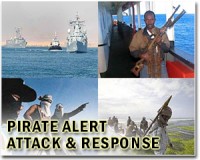| . |  |
. |
Nairobi (AFP) Oct 22, 2009 Attempts to curb Somali piracy by deploying warships or resuscitating the central government are doomed, and efforts should focus on buttressing local players in pirate hubs, according to a new report. The 71-page report entitled "Piracy in the Greater Gulf of Aden: Myths, Misconception and Remedies" argued that helping structures with local legitimacy -- such as the Puntland authorities and the Sufi militia Ahlu Sunna wal Jamaa -- could prove more viable. The report published by the Norwegian Institute for Urban and Regional Research (NBIR), seen by AFP Thursday, argued that the "containment" approach of naval patrols is costly and has shown mixed results. "The international naval presence is simply too small to cover the whole area" affected by piracy, the report said. The hijackings of the two-week-old inter-monsoon season during which pirates are most active has revealed a trend whereby the sea-bandits seek their prey ever further east in the ocean, away from the heavily-patrolled Gulf of Aden. The report noted that the international naval coalition "lacked any mechanism to address the onshore causes of piracy" and offered Somali opinion no local ownership of the anti-piracy drive. The NBIR paper cited the European Union's decision to give the leadership of its Atalanta force to Spain for four months earlier this year as a faux-pas that had fostered public resentment. "It is widely known that Spanish trawlers fish illegally in Somali waters, and the move was highly unpopular among Somalis," it said. The report also argued that the cost of naval action was not sustainable, and that piracy would likely re-appear should a decline in attacks eventually lead to a withdrawal of foreign warships. The author, Somalia expert Stig Jarle Hansen, pointed out that the cost of one Norwegian frigate deployed for six months -- around 30 million dollars -- would pay salaries to 100,000 Puntland police officers over the same period. NBIR's Hansen is also critical of a strategy centered around the western-backed Transitional Federal Government (TFG) which controls none of the areas home to pirate lairs and is often unable to pay its forces. "Piracy cannot be handled in areas in which piracy does not exist," he said. The report argued that "pirates are a product of the lack/decline of local institutions rather than the lack of a state." Hansen argued that in the two main regions affected by piracy -- the northern breakaway state of Puntland and the state of Mudug, further south -- there were partners with whom to develop anti-piracy strategies. In Puntland, despite alleged complicity with the pirates, the authorities are feared and the region has recently been free of large-scale conflict. Outside Puntland, in the Mudug region, Hansen suggested that the Ahlu Sunna wal Jamaa faction -- whose main interests are not currently along the coast -- needed to be "persuaded and rewarded for expanding into piracy areas". The group recently took up arms to defend its Sufi brand of Islam against the hardline Wahhabi doctrine advocated by insurgent organisations such as the Al Qaeda-inspired Shebab and is believed to enjoy wide popularity. The report suggested three possible approaches that could be adapted to local realities: paying and training existing forces to fight piracy, setting up a separate entity with considerable autonomy, resorting to a private company on-shore instead of off-shore.
Share This Article With Planet Earth
Related Links 21st Century Pirates
 China vows 'all-out efforts' to rescue hijacked ship
China vows 'all-out efforts' to rescue hijacked shipBeijing (AFP) Oct 20, 2009 China vowed "all-out efforts" Tuesday to rescue a Chinese cargo ship hijacked in the Indian Ocean with 25 crew aboard, bringing to six the number of vessels currently in the hands of Somali pirates. This is the second time that a Chinese ship has been captured by marauding sea bandits in the area, after a fishing boat and its 24-member crew were held hostage for three months before being ... read more |
|
| The content herein, unless otherwise known to be public domain, are Copyright 1995-2009 - SpaceDaily. AFP and UPI Wire Stories are copyright Agence France-Presse and United Press International. ESA Portal Reports are copyright European Space Agency. All NASA sourced material is public domain. Additional copyrights may apply in whole or part to other bona fide parties. Advertising does not imply endorsement,agreement or approval of any opinions, statements or information provided by SpaceDaily on any Web page published or hosted by SpaceDaily. Privacy Statement |